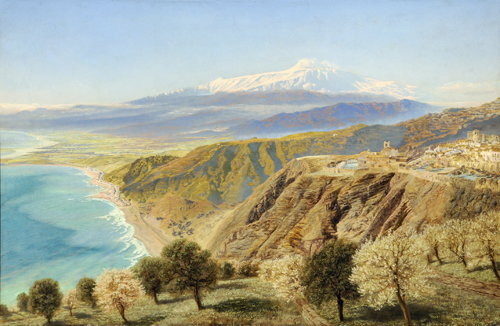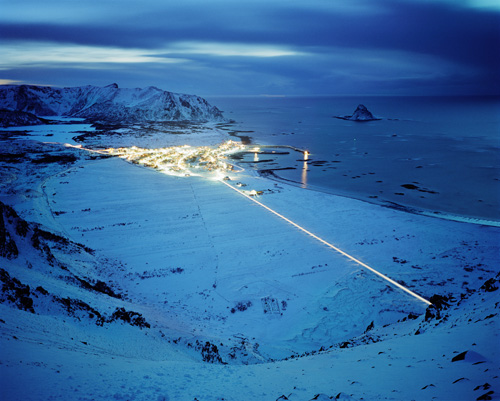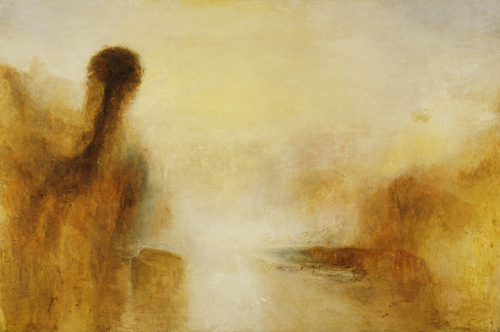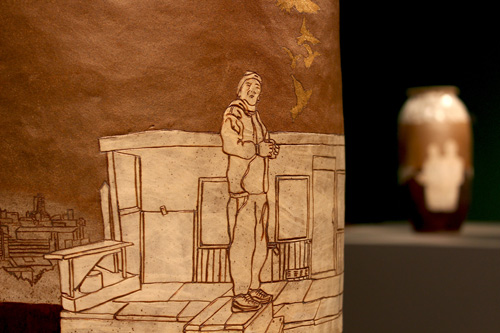
Force of Nature: Picturing Ruskin’s Landscape is the second in a three part series of exhibitions at Museums Sheffield looking at the Victorian polymath’s critical views on the way art intersects with the world around us. The 2009 exhibition posed the audacious question Can Art Save Us? investigating culture’s role in a sustainable future – a subject which, rather presciently, preoccupied Ruskin. In Force of Nature the critic’s thoughts on the representation of landscape are compellingly illustrated by his own work, works known to him and more contemporary pieces. The series benefits from a collection that Ruskin left to the city – a consolation for the industrial blight – as well as the funding of The Guild of St George founded by the great man in 1871 and still going strong.
The exhibition starts with a section called The Mountain in Miniature detailing Ruskin’s views on the apprenticeship of the landscape artist, suggesting that in order to faithfully reproduce a panorama the artist must first sketch every pebble and leaf which makes up the vista. A tall order typical of Ruskin’s exacting standards and yet there is a delight in looking down the other end of the binoculars to see the correspondence between the grooves on a stone and the ridges of a mountain. One of the most stunning objects in this section is a contemporary sideboard by Jon Male which uses the grain of a variety of wood to recreate the patina of mountains decorating the surface. In this way the contrivance of the artist reveals an innate organic pattern which runs through both wood and stone.
Next Seeing the Landscape follows Ruskin’s early credo that landscape art should represent nature with realism. Such purism is shown to be problematic in works such as John Brett’s Mount Etna from Taormina where a sizable canvas depicts the mountain with geographical accuracy and yet misrepresents the neighbouring settlement, turning it into an abandoned ruin so as not to distract from the peak. Nearby contemporary artist Dan Holdsworth’s photograph Andoya is also produced with an eye to verity using chemical processes rather than digital manipulation. However he takes the juxtaposition of timeless peaks with flickering electric light as a point of interest rather than trying to hide the human industry. Elsewhere Turner’s exquisite works and Ruskin’s own workmanlike sketches reveal that realism rather depends on the skill of the artist.

Holdsworth, 2012
Admirable as these works that aim for visual truth are, just as their preciseness starts to pall the exhibition changes direction, as indeed Ruskin’s thinking did. While travelling the world, Ruskin found some of the paintings he had admired so much for their accuracy, had in fact used artistic license to manipulate the geography of the view in favour of emotional truth. In this way Sensing the Landscape looks at how art can only ever represent a human viewpoint on the landscape and therefore often concerns itself with how these sights make us feel as much as what they look like. The most palpable example of this is Julian Opie’s stunning Jet stream, an LCD animation in which an ordinary roadside scene of daisies dancing on the breeze is brought vividly to life. This luminous, hyper-real light box is so redolent of an English summer’s day it’s as good an antidote to Seasonal Affective Disorder as I’ve seen. Equally evocative is Turner’s huge Landscape with Water, which uses layers of oil paint to recreate sunlight shimmering on water in an entirely abstract yet potently real way, summoning a sense memory from the viewer.

As a means of contextualising the exhibition and bringing a bit of the local landscape into the gallery, the display ends with some images of the Sheffield cityscape – the famous intersection of urban, industrial and bucolic peak district. There are some gems from the Museums Sheffield collection including Paul Waplington’s charcoal drawing Wybourn Estate from Manor Park plus local artist Emilie Taylor’s pots celebrating some of the less salubrious parts of Sheffield in stoneware. In response to the Ruskin collection Steve Poole and Kate Genever present The Business of Life – To Know, a huge flower press which will reveal different images from between its leaves as the exhibition continues, with contributions from local people.

The words Landscape and Ruskin might not immediately inspire a contemporary audience, the former suggesting postcard dullness and the later a dry and dusty cultural busy body. However, this exhibition sets up a vividly realised dialectic about whether our experience of nature can be challenged through a frame, whether such representations should have an aesthetic or emotional truth and how art can bring the vast indifference of mountains, forests and lakes down to a human scale.
The exhibition is free and runs at Museums Sheffield: Millennium Gallery until 23 June 2013.
I could have watched Jet Stream for hours – so evocative and such a contrast to the day outside. I also enjoyed the journey of the Wooden Boulder in Wales as it started being newly cut from oak and over the next 25 years made its way down a stream to the ocean. I keep wondering where it is now.